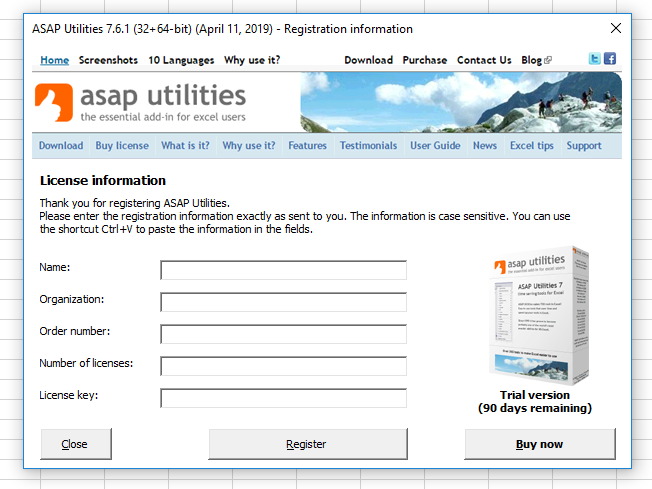
- ASAP UTILITIES 7.4 CRACK CRACKED
- ASAP UTILITIES 7.4 CRACK SOFTWARE
- ASAP UTILITIES 7.4 CRACK CODE
- ASAP UTILITIES 7.4 CRACK CRACK
- ASAP UTILITIES 7.4 CRACK WINDOWS
What other options are there to signature or behavior based scanning? I'm hearing plenty of the "cloud" AV "model" but that really isn't something new.
ASAP UTILITIES 7.4 CRACK WINDOWS
I know it is not apples-to-apples, as WoW is a lot less common than Windows XP, but it really wouldn't take much effort for someone that size to build a testing sandbox that will run their updates (at LEAST definitions and detections) and check for snags.Īpparently, gone are the days to where a vendor tests anything in the common real-world situations.And also many other internal IT departments (whoops)! McAfee got a lot of egg on their face for not testing their DAT against a very common, and standard, XP SP3 configuration and you'd think other vendors would take note. Common sense says, don't butt heads with Sony Legal, but ethical sense says (to me at least) that the Sony DRM crud really ranks worse than an IP scanner in my opinion.Īs to the main story though, AV vendors SHOULD be testing their systems against common configurations. I'd love to say this is not, and should not be, an ethics battle but the "Sony rootkit" issue really bothers me. Usually these hacktool/ip scanners/etc show up in these detections which is everything any admin can ask for.
ASAP UTILITIES 7.4 CRACK SOFTWARE
Most AV software (enterprise) contains a "PUP" grouping of detections and/or options. We don't pay Antivirus vendors to be ethics police, and false positives, ESPECIALLY ones that are done on purpose such as I have noted above, harm the vendors' credibilities all around.
ASAP UTILITIES 7.4 CRACK CRACKED
They openly admitted that their engine would claim such files to be a threat, and gave some limp reason about how running cracked versions of software is unsafe.

ASAP UTILITIES 7.4 CRACK CRACK
I asked how their engine would handle a legitimate/working crack or keygen for their products, files which were ENTIRELY not a threat to a system. False positives do not help anyone, whatsoever.Īt one point when looking for an anti-virus solution, I contacted Eset, maker of NOD32. I do not understand why this practice persists, or why customers put up with it.
ASAP UTILITIES 7.4 CRACK CODE
It is obvious that such files are detected via hashes and not any detected signature, all the while it is easy to detect that these files will not do ANY harm to a system without added code or payloads. but that is not how or why such files are getting flagged in their original and -verifiably non-harmful state, these files are still marked as threats by a disturbingly high percentage of vendors, with such dodgy labels as "hacktool" or "suspicious" or even that the executables are "packed" (compressed, a common practice). Yes, sometimes such things can be used in hacking/virus toolkits, or ortherwise come with malware payloads added by a third party. Such flaggings range from sometimes-shady cracks and keygens, to legitimately useful utilities like CMDow.

One thing I am massively annoyed by is antiVIRUS vendors that insist on purposely flagging NON-harmful files as harmful. If any anti-virus companies have any documentation on futuristic anti-malware research directions that they can let me read I would be fascinated to have it. Rick Wanner - rwanner at isc dot sans dot org You can submit them either via our comment mechanism at the bottom of this diary, or via our contact page. It seems to me that since these attempts require a little more "fuzzy" approach to anti-virus won't these sorts of false positives likely become more common, not less?Īre we getting to the point where software providers are going to have to start testing their updates against common anti-virus products before release?Īs usual I am interested in your opinions. Most of these are attempts at more heuristic or behavior based products that rely less on signatures. I have been watching with great interest the attempts to develop a new paradigm that fits better in the modern computing reality. The rash of false positives in recent months is just one symptom of that. The Anti-Virus paradigm we have used since the 80's is seriously flawed, and in my opinion is slowly unraveling. I have been interested for a while in the accuracy of Anti-Virus products in the modern computing world. What exactly are they triggering on? Is this an old signature from a previous issue? What I find interesting in this case is not that we have another anti-virus false positive, but that Symantec is listing as an InfoStealer and that it appears this false positive has happened on past World of Warcraft patches/updates that created a file called. Judging by the traffic on this topic in the WoW forums it would appear these are not isolated reports.Īctivity = Auto-Protect has detected Infostealerĭate & Time = (various times from 9:00 to now)įile Name = c:userspublicworld of We have had a couple of reports over the last 24 hour of users experiencing issues with Symantec anti-virus products triggering on which is a component of World of Warcraft.


 0 kommentar(er)
0 kommentar(er)
